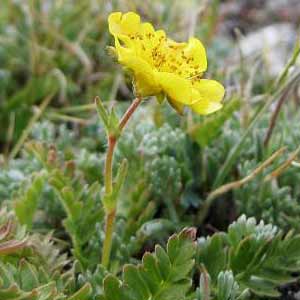Geum rossii
(synonym of Geum rossii var. depressum)
Geum glaciale
Ross' avens
glacier avens
4–28 cm, glabrous or downy, hairs to 1 mm, sometimes septate-glandular.
2–30 cm, densely pilose, hairs 2–5 mm.
basal 3–13 cm, blade pinnate to interruptedly pinnate, major leaflets 13–26, alternating with 0–14 minor ones, terminal leaflet slightly larger than major laterals;
cauline 0.7–2 cm, stipules adnate to leaf, indistinguishable from pair of lobes, blade bractlike, not resembling basal, alternate, simple, pinnatifid to 3-fid.
basal 3–10 cm, blade pinnate-pinnatifid, leaflets/lobes 11–23, terminal leaflet slightly larger;
cauline 1.4–2.5 cm, stipules adnate to leaf, indistinguishable from lobes, blade bractlike, not resembling basal, alternate, simple, 3-fid.
1–3(–4)-flowered.
1-flowered.
woolly, sometimes glandular.
densely pilose, eglandular.
erect;
epicalyx bractlets 1.5–7 mm;
hypanthium green, slightly purple-tinged to strongly purple;
sepals erect to erect-spreading, 3–10 mm;
petals spreading, yellow, obovate to nearly orbiculate, 5–12(–17) mm, longer than sepals, apex broadly rounded to irregularly emarginate.
erect;
epicalyx bractlets 6–9 mm;
hypanthium green;
sepals spreading-erect, 7–14 mm;
petals 5–9, spreading, yellow, obovate, orbiculate, or ovate, 10–20 mm, longer than sepals, apex rounded to emarginate.
sessile, glabrous.
sessile, silky.
wholly persistent, not geniculate-jointed, 2–5(–10) mm, apex not hooked, glabrous throughout or pilose only at base.
wholly persistent, not geniculate-jointed, 18–30 mm, apex not hooked, pilose except distal 1–3 mm.
= 56.
= 28.
Geum rossii
Geum glaciale
The variability accommodated here in Geum rossii was distributed by earlier monographers such as P. A. Rydberg (1913b) and F. Bolle (1933) among a half dozen species. W. Gajewski (1957) reduced them to two species, G. rossii and G. turbinatum; most recent taxonomists have recognized the two taxa as subspecies or varieties of a single species. The large geographic discontinuity between the Rocky Mountain and arctic ranges makes it easy for those wishing to follow this tradition. No one morphologic character or combination of characters neatly separates the arctic plants from those of the Rockies.
Where their ranges overlap in Alaska, Geum rossii hybridizes with G. calthifolium to form sterile plants known as G. ×macranthum (Kearney ex Rydberg) B. Boivin; see discussion under 4. G. schofieldii.
(Discussion copyrighted by Flora of North America; reprinted with permission.)
Flowers of Geum glaciale have from five to nine petals with seven being the most common. Other species of Geum nearly always have five petals, which is standard in most rosaceous genera. The sepals of G. glaciale are usually in two whorls for a total of about ten, and the bractlets are in two to three whorls. The exact number of epicalyx bractlets and sepals is made difficult to determine by the thick covering of hairs and because individual sepals and bractlets are sometimes deeply divided into two equal lobes.
(Discussion copyrighted by Flora of North America; reprinted with permission.)
- Local floras:
BC,
OR,
WA
- Local Web sites:
CalFlora,
CalPhotos,
Flora NW,
PNW Herbaria
WildflowerSearch
iNaturalist (observations)
USDA Plants Database
- LBJ Wildflower Center
- SEINet
- Plants of the World Online
- Encyclopedia of Life
- Wikipedia
- Google Image Search
